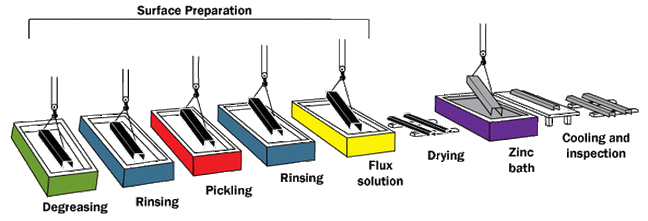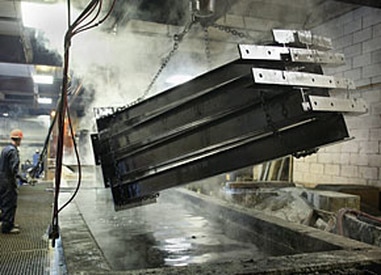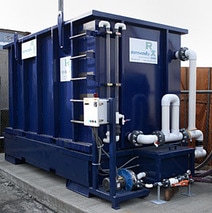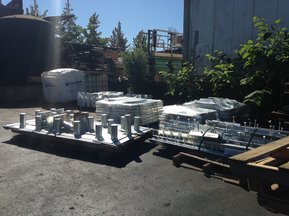What is Hot Dip Galvanizing?
Hot dip galvanizing is the process of applying a zinc coating to fabricated steel structures and parts by immersing them in a molten zinc bath, creating a metallurgical bond to the steel. The galvanized coating provides both barrier and cathodic protection against corrosion.
The Galvanizing Process
Surface Preparation
Surface preparation is the most critical step in the galvanizing process. Molten zinc will not react properly or metallurgically bond properly to the steel if it is not perfectly clean. Any failures or inadequacies in surface preparation will be immediately apparent when the steel is withdrawn from the molten zinc because the unclean areas will remain uncoated.
The three primary steps for surface preparation are:
- Caustic Cleaning (Degreasing)
- Acid Pickling
- Fluxing
Cleaning
The metal is first immersed into an degreasing solution to remove surface dirt, grease and oil from the metal surface.
The cleaning will not remove paint or the black lacquer that is commonly found on pipe. Removing paint or lacquer is commonly removed by an abrasive shot blast and is an additional cost.
Acid Pickling
The metal is immersed into a hot sulfuric acid solution to remove light mill scale and rust. Pickling time is determined by the cleanliness of the steel and by different types of steel. We do not pickle steel coated in heavy mill scale as it is not efficient for the customer. Sandblasting is recommended for parts with heavy mill scale.
Fluxing
Fluxing is the final step in the galvanizing process. Steel materials are dipped in aqueous solution of zinc ammonium chloride. Fluxing removes oxides and prevents further oxides from forming on the surface of the metal prior to galvanizing and promotes bonding of the zinc to the steel surface. Materials removed from the flux are air dried before galvanizing.
Between each step in the cleaning process the steel material gets a quick rinse in water to prevent cross-contaminating different solutions. Once the material has been properly cleaned it is ready to be galvanized!
|
Galvanizing
In this step the steel is completely immersed in a bath consisting of a minimum of 99.997% or better special high grade molten zinc. The zinc bath temperature is maintained at 840 degrees Fahrenheit. The steel is immersed long enough to reach 840 degrees. The articles are slowly withdrawn from the bath on an angle to allow excess zinc to run off and out of holes. Any excess zinc is removed by light filing, wiping, and/or centrifuging. Emerald Galvanizing is the only galvanizer in the greater Seattle area to have a centrifuge. We have two centrifuges: one is an electric spinner which spins smaller parts and the other is an air spinner which spins larger parts. All threaded products 30” long or under are run through our electric centrifuge to clean off excess zinc so that a nut will screw onto the bolt or rod. Anchor chains that are run through our centrifuge spin off excess zinc on the links to ensure the links stay pliable and don't stick together. Parts under 1/2" in diameter may become lost in production up to 5% of the total # of pieces. |
Inspection and Quality Control
Once materials are galvanized they are quenched in water or air-cooled for handling and final inspection. The most important method of inspection for galvanized steel is the thickness of the zinc which protects the steel from corrosion. The thickness of our galvanized coating meets applicable ASTM Standards. Other things we check are the uniformity of the coating, the adherence of the coating, and the appearance.
Once materials are galvanized they are quenched in water or air-cooled for handling and final inspection. The most important method of inspection for galvanized steel is the thickness of the zinc which protects the steel from corrosion. The thickness of our galvanized coating meets applicable ASTM Standards. Other things we check are the uniformity of the coating, the adherence of the coating, and the appearance.
|
Storm Water Treatment System
At the end of the inspection and quality control process, your product is ready to ship - but for Emerald Galvanizing there is one final step. Emerald is proactive in keeping the environment clean. We recently installed state-of-the-art equipment to process and treat storm water that comes off our roof and our paved yard. The tested results for the first quarter of 2019 showed that Emerald Galvanizing passed all Washington State Department of Ecology benchmark requirements for clean storm water! |





